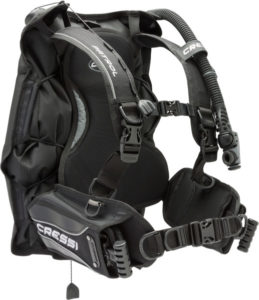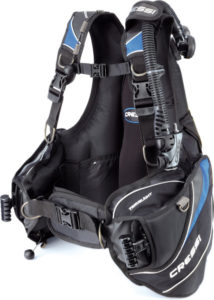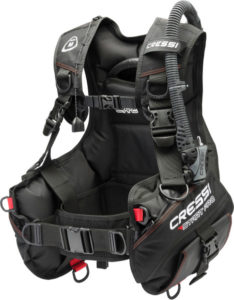When it comes to choosing the right BCD, lots of factors will affect your decision. You’ll want to consider how much to spend, which type of BCD goes best with your diving style, how much weight you carry, where you want the jacket’s air to sit on your body, and even your body type. Here we’ll highlight the three main BCD styles, along with a few other options to help make choosing the right BCD a little easier.
 Jacket-style BCD
Jacket-style BCD
The jacket-style BCD is by far the most common. The air bladder inside the jacket fills up around the waist and the chest when inflated. The jacket-style is quite comfortable if you choose the proper size. Make sure to try a few on before you make a purchase. One that’s too small will squeeze; one that’s too large will ride up on your shoulders. Most modern jacket BCDs feature an integrated weight system as well, which makes a weight belt unnecessary. Different sizes feature different lift capacities.
Many jackets also feature zippered or Velcro pockets on the sides or inside for storing accessories such as SMBs and torches. The jacket-style BCD is tremendously stable in all water positions. Air placement can make it slightly challenging to maintain a horizontal position underwater.
If you’re looking for a durable, comfortable and easy-to-use (not to mention affordable) jacket-style BCD, try the new Start Pro 2.0 from Cressi, which retails for $329.95.
Back-inflate BCD
 The emerging favorite of recreational diving, the hybrid or back-inflate BCD features an air-bladder design wherein the air in the bladder is distributed along the diver’s back, which makes maintaining a horizontal position in the water far easier. This type of BCD usually features pockets for storage and integrated weight system as well, just like the jacket-style BCs. It can be slightly more difficult to maintain a vertical position at the surface.
The emerging favorite of recreational diving, the hybrid or back-inflate BCD features an air-bladder design wherein the air in the bladder is distributed along the diver’s back, which makes maintaining a horizontal position in the water far easier. This type of BCD usually features pockets for storage and integrated weight system as well, just like the jacket-style BCs. It can be slightly more difficult to maintain a vertical position at the surface.
The lightweight new Cressi Patrol clocks in at a little over 6 pounds (2.9 kg) for the large and features an air-cell compression strap that makes volume control easy. It retails for $399.95.
Back-plate-and-wing BCD
Perhaps the most multipurpose, back-plate-and-wing BCDs are becoming popular not just among technical divers but recreational divers as well. There are infinite combinations when it comes to choosing which back-plate and wing combination you’d like, but those new to this system of diving should seek the advice of experienced divers when completing their own sets. The back-plate-and-wing system is a fantastic choice for divers who are planning more advanced and technical diving such as wreck, deep and cave exploration. Above all, though, the wing’s comfortable feel is driving its popularity, offering the sensation of not diving with a BCD at all.
The DiveRite TransPac is a great choice, with lots of different configurations and options.
Other styles
 Sidemount diving has also gained popularity in recent years, evolving mainly from cave diving. This system involves diving with the tanks under your arms or on your sides, and is quite popular among technical divers due to easier access to small places. This style of diving also shifts the weight of heavy tanks on the back to the side.
Sidemount diving has also gained popularity in recent years, evolving mainly from cave diving. This system involves diving with the tanks under your arms or on your sides, and is quite popular among technical divers due to easier access to small places. This style of diving also shifts the weight of heavy tanks on the back to the side.
As more women become involved in diving, many companies have begun to manufacture equipment designed specifically for them. Women’s BCDs are generally smaller, lighter, and tend to curve away from the chest, as well as offering more lumbar support. Many women’s BCDs also feature a shorter torso design.
Finally, due to the ever-increasing ease of travel, more divers are taking their own equipment abroad. The market is full of smaller and lighter travel BCDs that often offer much of the same functionality as a regular BCD but weigh much less. Plastic or aluminum rings, which are still strong but much lighter, usually replace heavier steel D-rings, and the unit’s general construction is usually much thinner. These BCDs can be a bit more fragile, though, so take care if you’re diving in rough conditions. Both the men’s and women’s medium Cressi Travelight weigh only 5.5 pounds (2.5 kg) and fold up nicely to fit into a dive bag.


